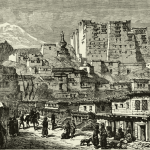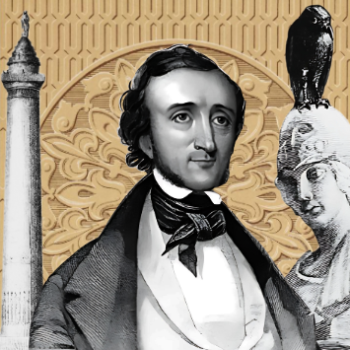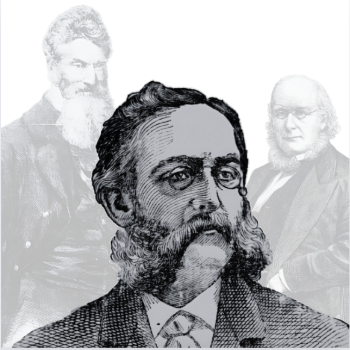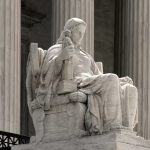THE MAT BATS ON THE MOON
In 1833 Greeley found himself lodging at a “Graham House,” that is, a boardinghouse modeled on the precepts of Sylvester Graham.[1] The Graham House also met a specific need, functioning as Abolitionist hotels, they catered to activists, both black and white, who were not welcomed anywhere else.[2] Here Greeley adhered to a strict vegetarian diet, and practiced a vigorous regimen of cold baths, temperance, and other “self-purifying” acts of discipline that helped him cope with his uprooting and replanting in “Gotham.” Individual moral responsibility, social harmony, sobriety, and self-improvement, “were the essential terms of his moral vocabulary.”[3] European interest in the development of the body as a measure of regenerating both the moral and physical fiber of their respective nations. It began, unsurprisingly, with the advent of race theory and urbanization in the early nineteenth century. Each country developed their own gymnastic program and output of instructional books regarding “man-making” exercises. Donald Walker’s British Manly Exercises (1834,) for example, included new sports like sailing, horseback riding, and rowing. It was during the 1830s when English public schools included more sports along the lines of military training in the curriculum. With this came the adoption of a calisthenic regiment developed by the Swede, Pehr Henrik Ling (father of the Swedish Massage.)[4] “My wife [Mary Young Cheney,]” writes Greeley, “whose acquaintance I made at the Graham House, and who was long a more faithful, consistent disciple of Graham than I was, in our years of extreme poverty kept her house in strict accordance with her convictions.”[5] For a time Greeley lived in the Manhattan’s Sixth Ward, “eminent for filth, squalor, rags, dissipation, want, and misery,” he writes.[6] The famous frontier statesman, Davy Crockett, echoed this sentiment when he visited the Sixth Ward in 1834. “I thought I would rather risk myself in an Indian fight than venture among these creatures after night.”[7]

Five Points Streets Intersection Painted By George Catlin In 1827. (Source: Wiki.)
In addition to editing two Whig journals, in the spring of 1834, Greeley began editing his first weekly magazine, The New-Yorker.[8] (He would remain active in the New York Whig Party for the next twenty years as one-third of a powerful triumvirate that included William Henry Seward and Thurlow Weed.)[9] Media, the plural of “medium,” was the Latin word for “middle,” indicating an intermediate channel of communication. The word itself can be found in intermediate (as well as mediocre, mediate, medieval, etc.)[10] The press rarely took a middle position, however, because people don’t consume news media to get a neutral opinion, they do so to confirm their own biases. “The neutral and colorless journal, which had been so frequent before the Revolution, and during its progress,” it was said, “almost entirely disappeared.”[11] There was no shortage of sensational topics. 1834 was a “great riot year,” as in there were riots (or riots brewing) in nearly every city. There were race riots, anti-Catholic and anti-Irish riots in Boston, and “anti-foreign” scrimmages in the streets of New York. There were economic riots in Baltimore after the failure of the Bank Of Maryland. Meanwhile, organized Abolitionist militants were met with anti-black mobs in Philadelphia, Cincinnati, Newark, and Connecticut.[12] When it was a slow news period, there was always the option of just inventing fiction.

“A lithograph of the hoax’s ‘ruby amphitheater,’ as printed in The Sun.” (Source: Wiki.)
One such fiction, the “Great Moon Hoax,” an incredible blend of science fiction and practical joke, fooled hundreds of thousands of readers around the world and made The Sun, a two-year-old New York daily, the top-selling newspaper in the world. The man behind this hoax was the Cambridge graduate, Richard Adams Locke, a descendant of the philosopher, John Locke. In the summer of 1835, after trying to secure jobs in both Britain and America, Locke landed a position at The Sun. The literary organ of printer and publisher, Benjamin Day, The Sun was a popular tabloid in the “Penny Press Era,” when cheap papers using simple language were made to satisfy the demands of immigrant communities. As one biographer wrote at the time:
When the Historian of the United States shall have completed the work that has occupied so many busy and anxious years, and in the tranquil solitude of his study he reviews the long series of events which he has narrated, the question may arise in his mind—Which of the events that occurred during the first seventy years of the Republic is likely to exert the greatest and most lasting influence upon its future history? Surely he will not pause long for a reply […] It was the establishment of the first penny daily paper in the city of New York in the year 1833 […] A catastrophe happens today in New York. New Orleans shudders tomorrow at the recital; and the Nation shudders before the week ends. A “Great Word” uttered on any stump in the land, soon illuminates a million minds. A bad deed is perpetrated, and the shock of disgust flies with electric rapidity from city to city, from State to State—from the heart that records it to every heart that beats. A gallant deed or a generous one is done, or a fruitful idea is suggested, and it falls like good seed, which the wind scatters over all the land at once.[13]
Often covering human interest stories, its emphasis on the “common man” was something of a novelty, and with a much lower price than other papers (1-cent rather than 6-cents,) The Sun became very popular. The four-page paper, printed quickly on a steam press, had a daily circulation of 8,000—easily outselling its competitors, including its chief rival, James Gordon Bennet’s New York Herald. This success of The Sun attracted many advertisers, the revenue of which afforded the paper a degree of financial independence of politicians previously unseen. Locke and Day knew that to increase circulation (and keep up with Bennett) they would need to publish a story that would hook their readers. Locke proposed a sensational, serialized 17,000-word story that would be published over six days beginning on August 21, 1835. The drip-feed of a “plot” involved the astronomer, Sir John Herschel, and his discovery of a civilization on the moon. The creatures, the articles said, were named Vespertilo-homo (man-bat) by Herschel. That was not all—there was also a mysterious temple on the moon. The articles state:
It was a temple—a fane of devotion, or of science, which, when consecrated to the Creator, is devotion of the loftiest order; for it exhibits his attributes purely free from the masquerade, attire, and blasphemous caricature of controversial creeds, and has the seal and signature of his own hand to sanction its aspirations. It was an equitriangular temple, built of polished sapphire, or of some resplendent blue stone, which, like it. displayed a myriad points of golden light twinkling and scintillating in the sunbeams. Our canvass, though fifty feet in diameter, was too limited to receive more than a sixth part of it at one view, and the first part that appeared was near the centre of one of its sides, being three square columns, six feet in diameter at its base, and gently tapering to a height of seventy feet. The intercolumniations were each twelve feet. We instantly reduced our magnitude, so as to embrace the whole structure in one view, and then indeed it was most beautiful. The roof was composed of some yellow metal, and divided into three compartments, which were not triangular planes inclining to the centre, but subdivided, curbed, and separated, so as to present a mass of violently agitated flames rising from a common source of conflagration and terminating in wildly waving points. This design was too manifest, and too skillfully executed to be mistaken for a single moment. Through a few openings in these metallic flames we perceived a large sphere of a darker kind of metal nearly of a clouded copper color, which they enclosed and seemingly raged around, as if hieroglyphically consuming it.[14]
The circulation of The Sun increased to 19,360, and crowds stormed the newspaper office eagerly anticipating the next installment. The printing office of Bennet’s New York Herald burned down just days after the publication of the first installment of the story, leaving few to seriously question the narrative in the beginning. It would take weeks before anyone could verify if the story was true. The Sun, from the beginning, maintained that their information was obtained from The Edinburgh Journal Of Science. (Many failed to realize that said journal had been defunct for two years at that point.) When pressed for an explanation, Locke and Day refused to admit to the hoax and shifted the blame to their sources in Europe.[15]
SOURCES:
[1] Tuchinsky, Adam-Max. “‘The Bourgeoisie Will Fall And Fall Forever’: The ‘New-York Tribune,’ The 1848 French Revolution, And American Social Democratic Discourse.” The Journal Of American History. Vol. XCII, No. 2 (September 2005): 470-497.
[2] Burrows, Edwin G.; Wallace, Mike. Gotham: A History Of New York City To 1898. Oxford University Press. Oxford, England. (1998): 533-534;
Haynes, April. “Radical Hospitality And Political Intimacy In Grahamite Boardinghouses, 1830–1850.” Journal Of The Early Republic. Vol. XXXIX, No. 3 (Fall 2019): 397-436.
[3] Greeley, Horace. The Autobiography Of Horace Greeley. E.B. Treat. New York, New York. (1872): 145-146.
[4] Singleton, Mark. Yoga Body: The Origins of Modern Posture Practice. Oxford University Press. Oxford, England. (2010): 81-94.
[5] Greeley, Horace. The Autobiography Of Horace Greeley. E.B. Treat. New York, New York. (1872): 104.
[6] Greeley, Horace. The Autobiography Of Horace Greeley. E.B. Treat. New York, New York. (1872): 145.
[7] Crockett, Davy. An Account Of Col. Crockett’s Tour To The North And Down East. E.L. Carey And A. Hart, And Co. Philadelphia, Pennsylvania. (1835): 49.
[8] William, Robert C. Horace Greeley: Champion Of American Freedom. New York University Press. New York, New York. (2006): 32.
[9] Snay, Mitchell. “Horace Greeley’s New-Yorker: The Newspaper As Literary Institution In Jacksonian America.” New York History. Vol. XCII, No. 1/2 (Winter/Spring 2011): 41-51.
[10] Skeat, Walter William. A Concise Etymological Dictionary Of The English Language. Harper & Brothers. New York, New York. (1882): 277-278.
[11] “To this political stimulus may be directly traced the immediate multiplication of newspapers, and the fact that they rapidly attained a degree of influence hitherto unknown in America, and probably not previously paralleled in the world. They were born of the friction generated by intense political feeling, and were very often established under circumstances which foredoomed them to failure as business enterprises, by men carried away by intensity of political opinion or prompted to the venture by other men who desired to make use of public prints for political purposes. The neutral and colorless journal, which had been so frequent before the Revolution, and during its progress, almost entirely disappeared […] The political opinions of a newspaper not only offered an inducement to subscribers of its manner of thinking, and thus spread the circulation among many who would not otherwise have taken it, but offered certain other advantages, such as the petty patronage in printing which political parties are able to supply and the favor, and frequently the sustenance, of politicians who were in positions of more or less power. Hence it happened that these early newspapers were divided in their political opinions very nearly in accordance with the well-known geographical distribution of politics.” [North, Simon Newton Dexter. History And Present Condition Of The Newspaper And Periodical Press Of The United States. U.S. Government Printing Office. Washington, D.C. (1884): 31.]
[12] “The Great ‘Riot Year’: Jacksonian Democracy And Patterns Of Violence In 1834.” Journal Of The Early Republic. Vol. V, No. 1 (Spring 1985): 1-19.
[13] Parton, J. The Life Of Horace Greeley. Mason Brothers. New York, New York. (1856): 137-138.
[14] Locke, Richard Adams. The Moon Hoax; Or, A Discovery That The Moon Has A Vast Population Of Human Beings. William Gowans. New York, New York. (1859): 43.
[15] Vida, István Kornél. “The ‘Great Moon Hoax’ Of 1835.” Hungarian Journal Of English And American Studies. Vol. XVIII, No. 1/2. (Spring-Fall2012): 431-441.













